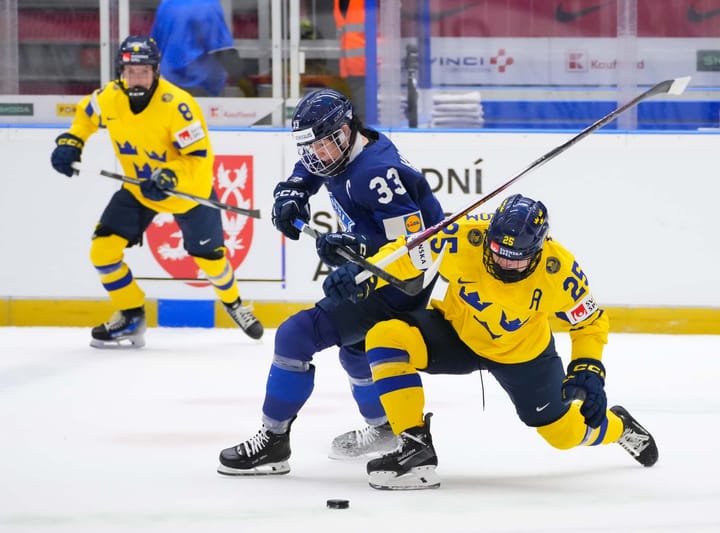A closer look at scoring efficiency: worth using for women’s hockey?
What is SE% and is it something we should be paying attention to?
Scoring efficiency.
That's the name of the game if you’re the IIHF, apparently. Now, I will admit when I first saw this statistic I literally called it a poor man’s Corsi. However, it took less than 24 hours for me to come around to it, partially because...well, beggars can’t be choosers. It’s also the first time in a while that I have seen a #fancystat that can be widely applied across every league that has access to just a basic box score.
So why should you care about scoring efficiency, or SE% as I am going to refer to it from now on? For starters, it's not actually anything like Corsi, despite my earlier comment about it. The basic equation for SE% is as follows- and when I say basic I really do mean basic.
All Situations Goals / All Situations Shots = Scoring Efficiency %
And while it’s nothing groundbreaking - simply the inverse of the opposing goalie’s save percentage or shooting success percentage, if you will - it does bring up the interesting conundrum of why we haven’t been looking at this all along. After all, in leagues that are notoriously stat-poor (honestly, my kingdom for players’ TOI or even just situational shot tracking) is this something we have been potentially sleeping on for the better part of forever? Or is it something we should discard and give up on immediately?
To investigate this point, I decided to look at the CWHL’s 2016-17 season to see if we could use SE% to measure a team’s effectiveness. However, since we don’t want to just look at a team’s scoring efficiency, instead of the team's overall effectiveness on the ice, we’re going to combine it with team save percentage, commonly known as SV %.
Here we have every CWHL team on a scatter plot, with the horizontal axis being a team’s shot efficiency and the vertical line representing team save percentage. So naturally, working off that assumption, we should expect good teams to be closer to the top right-hand corner and bad teams closer to the bottom left. The grid is then divided into quadrants using the averages of the two measures.
Expanding on this, teams that are in the top right quadrant should be good, having both a high save percentage and a high scoring efficiency rank. Teams in the bottom quadrant are what I would classify as fun teams, the high-risk, high-reward group. Their scoring efficiency is above average, but their goaltending leaves a little to be desired.
The bottom left are those teams that have both a low level of scoring efficiency and below average goaltending, while the top left, despite being labeled ‘lucky’ should really be called ‘go to the shops and buy your goalie a muffin basket right now omg do you not love them or something.’
With that in mind, each team’s positioning was pretty much where we expected them to be. The Boston Blades struggled for the second year in a row, ending the season with a goal differential of -103. Their SE score wasn’t actually as bad as I expected it to be, with the team scoring on 12.5% of their shots. The issue, however, is when we look at their actual shot count, which was 34% less than the league average.
The Furies were bailed out more than once by goalie Christina Kessler over the course of their season. Their closest geographical rivals, Brampton, finished in the middle of the pack, and according to these numbers were almost perfectly average.
It's in Calgary and Montreal's positioning that we see the first really unexpected results, with the two teams being much further apart than overall records and head-to-head games would indicate. So in the interest of getting out of my ‘spreadsheet basement’ (which is rude, given I live on the second floor of my building) and into the real world, I hit up some of the CWHL writers here at The Ice Garden to see if I was just losing my mind or if there was some method to the madness.
Montreal is a high-shooting team, shooting 27% more than league average and 60 shots more than their closest counterpart Calgary. That being said, they’re a ‘big game’ type club, which is to say they can and will rise to the occasion as needed. They split their series against Calgary, but they also suffered some big losses against teams like Toronto as well as struggling a little bit in the goaltending department. All this added up to a wildly inconsistent season.
If we look at Montreal's scoring efficiency across the season, it varied massively from game to game. While they had some dominant performances and eventually won the Clarkson Cup, there was a lack of consistency in their results, which ended up landing them just above league average in SE%.
In comparison, Calgary, while not without their peaks and valleys, were much more consistent, as shown by their rolling average not having the same level of erratic movement that Montreal displayed. Their average stayed between 10-20% for the length of the season whereas Montreal's varied by over 15%.
So Alyssa, is it worth it? Is this a stat we should be looking at?
Honestly, yes. Sometimes the analysis is just a case of throwing it at the wall and seeing what sticks, and at this point in time I’m not prepared to write scoring efficiency off as useless. I definitely think it lends itself more towards long-term trends than single game analysis; after all, everyone’s going to have a game or two where they run into a hot goalie or where the bounces really just don’t go your way. However, I think that looking at long-term trends, league-wide data, and using it in tandem with things like team save percentage and all situations PDO, it has the potential to lend itself to a deeper understanding in women’s leagues where there isn’t necessarily the greatest collection of data to draw from in the first place.





Comments ()